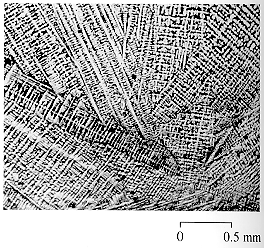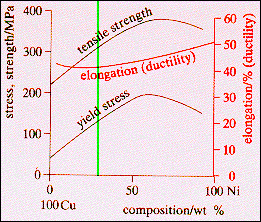| |
When
the Cu - 30 wt% Ni alloy solidifies it develops the microstructure shown in the
photograph. The solid is not a single crystal, but is made of many crystals
joining together at their boundaries. This polycrystalline material will
have properties that depend upon both the grain size and composition of the alloy.
The
lower diagram shows how the alloy composition alters mechanical
properties such as the yield stress, tensile stress, and the ductility of
the alloy. The vertical green line shows the Cu-30 wt % Ni composition. The
diagram shows that the pure elements have the lowest yield and tensile stress
and the highest ductility. As alloying elements are added their tensile and
yield stress increase and their ductility decreases. The alloy with the approximate
composition Cu-60 wt% Ni has the highest yield and tensile stress values
and a ductility similar to that of pure copper.
Control of the crystal
structure of the alloy can be achieved by controlling the cooling rate,
or by heat treating the alloy after it has been solidified. This will permit
further control of properties if the result is worth the extra production
cost. |
|
|

